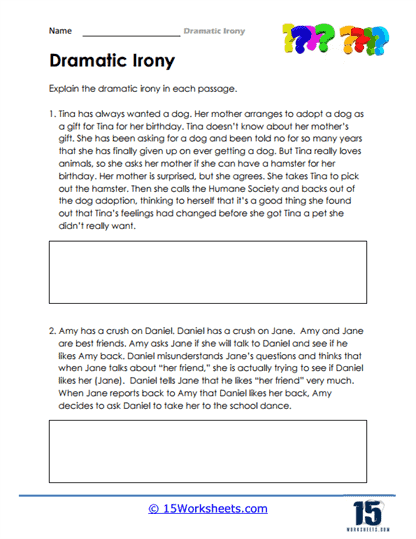Explain It

Worksheet Description
This worksheet is focused on the identification and understanding of dramatic irony through the analysis of two short passages. Each passage describes a situation where the characters are unaware of the full truth of their circumstances, while the reader is fully informed, creating a sense of dramatic irony. Students are prompted to explain the dramatic irony in each scenario, one involving a girl receiving a pet she did not desire, and the other involving a misunderstanding about romantic feelings among a group of friends. The colorful figures at the top signify the varied perspectives that contribute to the irony in these stories.
The worksheet is designed to teach students how to recognize dramatic irony and to understand its effect within a narrative. By analyzing the two different scenarios, students learn to discern how the audience’s additional knowledge creates a contrast with the characters’ understanding. This exercise also helps students to grasp how dramatic irony can add complexity and humor to storytelling. The task reinforces the importance of perspective in literature and improves students’ critical reading and thinking skills.
Explain the dramatic irony in each passage.
Example Passage:
Tina has always wanted a dog. Her mother arranges to adopt a dog as a gift for Tina for her birthday. Tina doesn’t know about her mother’s gift. She has been asking for a dog and been told no for so many years that she has finally given up on ever getting a dog. But Tina really loves animals, so she asks her mother if she can have a hamster for her birthday. Her mother is surprised, but she agrees. She takes Tina to pick out the hamster. Then she calls the Humane Society and backs out of the dog adoption, thinking to herself that it’s a good thing she found out that Tina’s feelings had changed before she got Tina a pet she didn’t really want.
